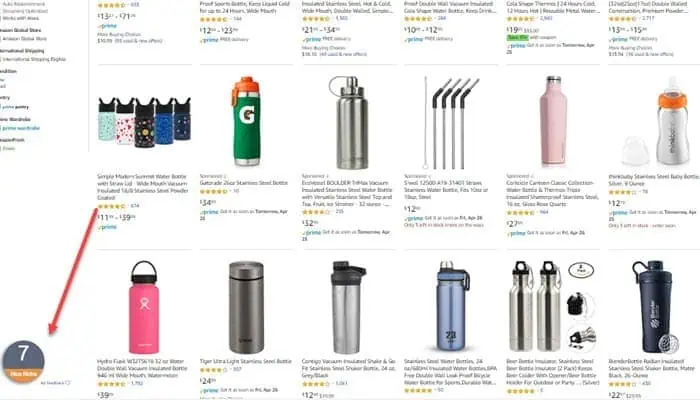The other day when talking about the need to have an Amazon strategy, I shared a story of “Matt” who was doing $3M in sales with great profitability – to now, barely breaking even and struggling to come up with profitable products.
Matt and hundreds of thousands of sellers (from the US and international) are now using the same scouting tools, like Jungle Scout to look up the same products. We use AMZ Scout which is the same thing, but I purposely avoided Jungle Scout in order to try and avoid getting our searches, product ideas and keywords being stored on the Jungle Scout database for all to find.
Why I don’t use scouting software for new products
It’s best to think of scouting software as a point-in-time tool. It provides historical data of what a product has done – never what a product will do in the future.
What this means is that you’ll never find products that solve an existing problem. Scouting tools will limit your findings to products that are currently already on the market.
If there’s enough demand based on what the stats show, a hoard of other sellers will be selling the same thing in a couple of months.
The best way to use a scouting tool is to find a new product, and then upgrade it or change it to become unique. But this also comes with challenges, as the Chinese supplier will likely start selling it to others unless you protect yourself with a NNN document or bilingual PO document with the owners signature.
That stainless steel bottle you come across is going to get more saturated by the time you get your shipment and are ready to sell.

This niche for “stainless steel bottle” shows up as a 7/10 for niche opportunity. Take a closer look and you’ll see how saturated it already is.
Making an improvement with a steel water bottle is going to be tough.
Don’t trust the opportunity scores from any of the tools. They are usually behind or just wrong.
The way we use scouting software is to monitor competitors and look up potential industry numbers. Rather than believing the numbers the tools give out related to a product, we take a broader look at the industry to determine whether it makes sense.
If you “must” use a scouting software, try something that isn’t used by everyone else. IO Scout is an alternative you should check out. Like other scouting software, you can find products with great potential and apply different filters to narrow down your search – including sales, revenue, price, reviews, sellers, stock status and more.
Now, here are some better and different ways that we’ve been able to come up with winning products.
1. Attending unique trade shows

This is an old school method, but it works.
For all the naysayers out there, not one of them will be able to give data to back up their reasoning other than their personal reason of not liking trade shows.
We don’t bother with the massive ones like Canton fair or the Home Show in Chicago anymore. Trade shows dominated by big brands are not worth the time unless you have connections to get great pricing for wholesale orders.
Most of the time, the big brands are not interested in selling to Amazon businesses.
Plus, the products are all about same and big brands don’t innovate. They continue to push what currently sells and what is safe. No reason to fix what is working.
In 2018, we attended our first Indie Beauty Show in New York. Filled with brands and unique products I’ve never seen before.
This is the type of show where you come away with a lot of product information as the vendors are mostly all small businesses – having to innovate in order to get their product noticed.
One product that caught my eye was Activated Charcoal Gum.
Activated charcoal products are “in” at the moment and people like to chew gum and whiten their teeth.
Light bulb.
This is the type of product that you won’t find via Jungle Scout.
In fact, it’s already been a year, but search on Amazon and there’s not a single charcoal gum product. The search results are filled with “charcoal powder” because that’s what scouting software shows.
That’s just one example.
At such shows, we’ll get a ton of ideas. Takes a lot of work to ruthlessly eliminate everything that does not fit within our product line and strategy.
2. Big Box Stores

The easiest way for us to find top sellers and high demand products is to simply visit Walmart, Target, Home Depot or any other big box store.
Amazon has their best sellers list, but I find it hard to figure out and being able to touch and feel the quality of a product makes a big difference.
I treat big box stores like showrooms and local trade shows. Big box stores only carry high turnover products. I know that anything being featured prominently at eye level on the wall, shelf or endcap is a hit item.
Let’s use yoga mats as an example.
Since I can’t find a way to improve on a yoga mat and simply increasing the thickness or size does not offer any competitive advantage, it may be a better idea to create products related to yoga, but not yoga mats.
- deep tissue massagers
- some uniquely shaped yoga block
- meditation incense or fragrances
- a pillow or support product
- and so on
Plenty of ways to serve the market without getting into a messy fight with me-too products.
Or find a reoccurring theme in the 1-3 star reviews and fix it. A lot of our hit products have been created in this way.
3. Traveling

You’re probably like “whaaaat?!” Who has time for that?
Outside the norm of day to day activities, your senses are open to new experiences. Have you noticed that you get great ideas when you are either in the shower, on the toilet or doing everyday normal things? Travel is like that too.
It helps that we mix in travel with business. We also benefit by expensing certain things for business too.
When we go to Europe, we’ll visit the big box retailers, little towns, markets, fairs, gift stores and see all these unique and fun products that we’ve never seen before.
Most probably won’t sell, but during my last visit to Japan, we were able to develop products based on some great ideas we caught over there.
I then turn the ideas over to software and just plug away on Amazon to find out what the current problems are, level of competition and potential sales volume.
Rather than making products with a looking-backwards approach all the time, we find new products with a forward looking method and then use the backwards approach to validate whether a product or idea has potential.
What about you?
Summary
- I just don’t use scouting software to find product ideas as my main method of choice.
- With scouting software, everyone else is looking at the same thing.
- Use old school techniques of sourcing products like trade shows, browsing through stores and discover new ideas in different countries.
Comments
Related Posts

10 Profitable Product Categories for Amazon Affiliates 2025
What you’ll learn Amazon is a favorite for experienced and…

Unlock the Secret to a Profitable Automated Amazon Store: How to Build a Hands-Free Income Stream
Ever dreamed of running a profitable Amazon business while sipping…

Master Amazon New Restricted Keywords: A Seller’s Guide to Success
Changes to Amazon’s restricted keywords list have taken a lot…





Leave a Reply